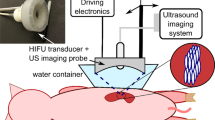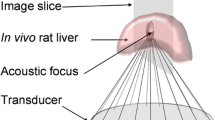Abstract
Eighty kidneys (40 left and 40 right kidneys) of New Zealand rabbits were ablated using high intensity focused ultrasound (HIFU), (14,300 W/cm2, 1.0 MHz). Kidneys were randomly divided into two groups. HIFU was performed in the manner of linear scan in both groups. Prior to HIFU, normal saline solution and isovolumetric microbubble agent were administrated intravenously in groups I and II, respectively. HIFU was finished in all left kidneys and in 26/40 right ones. The therapeutic efficiency was reflected using necrosis rate (cubic centimeters per second), which was the tissue volume of coagulative necrosis per 1 s HIFU exposure. In both groups, predetermined volumes were damaged without harming overlying tissues. Necrosis rates were increased in group II both in left (0.0089±0.0107 vs. 0.0493±0.0777, P=0.0323) and in right (0.0039±0.0055 vs. 0.0162±0.0168, P=0.0248) kidneys. Pathological examinations confirmed that there were no intact tissue focuses within exposed regions in either group. These findings suggested that the microbubble agent improved the therapeutic efficiency of HIFU. Hemorrhage and hyperemia were also detected on the margin of the ablated tissues (both in cortex and medulla) in both groups.







Similar content being viewed by others
References
Chapelon JY, Margonari J, Theillere Y, Gorry F, Vernier F, Blanc E, Gelet A (1992) Effects of high-energy focused ultrasound on kidney tissue in the rat and the dog. Eur Urol 22:147–152
Chen WS, Lafon C, Matula TJ, Vaezy S, Crum LA (2002) Mechanisms of lesion formation in high intensity focused ultrasound therapy. 2nd international symposium on therapeutic ultrasound. Seattle, Washington, USA, 29 July–2 August, p 30
Wu F, Wang ZB, Chen WZ, Zou JZ (2002) Extracorporeal high intensity focused ultrasound for treatment of solid carcinomas: four-year Chinese clinical experience. 2nd international symposium on therapeutic ultrasound. Seattle, Washington, USA, 29 July–2 August, p 11
Wu F, Chen WZ, Zou JZ (2002) Cancer treatment using HIFU. In: Feng R, Wang ZB (eds) Practical ultrasonic therapeutics. Scientific and Technical Documents Publishing House, Peking, pp 212–225
Chen L, ter Haar G, Hill CR, Dworkin M, Carnochan P, Young H, Bensted JP (1991) Effect of blood perfusion on the ablation of liver parenchyma with high-intensity focused ultrasound. Phys Med Biol 36:1661–1673
Wang Z, Bai J, Li F, Du Y, Wen S, Hu K, Xu G, Ma P, Yin N, Chen W, Wu F, Feng R (2003) Study of a “biological focal region” of high-intensity focused ultrasound. Ultrasound Med Biol 29:749–754
Fry FJ (1993) Intense focused ultrasound in medicine. Eur Urol 23[Suppl 1]: 2–7
Miller MW, Everbach EC, Cox C, Knapp RR, Brayman AA, Sherman TA (2001) A comparison of the hemolytic potential of Optison™ and Albunex® in whole human blood in vitro: acoustic pressure, ultrasound-frequency, donor and passive cavitation detection considerations. Ultrasound Med Biol 27:709–721
Blomley MJK, Cooke JC, Unger EC, Monaghan MJ (2001) Microbubble contrast agents: a new era in ultrasound. B M J 322:1222–1225
Miller MW, Miller DL, Brayman AA (1996) A review of in vitro bioeffects of inertial ultrasonic cavitation from a mechanistic perspective. Ultrasound Med Biol 22:1131–1154
Baker KG, Robertson VJ, Duck FA (2001) A review of therapeutic ultrasound: Biophysical effects. Phys Ther 81:1351–1358
Wu F, Chen WZ, Bai J, Zou JZ, Wang ZL, Zhu H, Wang ZB (2001) Pathological changes in human malignant carcinoma treated with high-intensity focused ultrasound. Ultrasound Med Biol 27:1099–1106
Wu F, Chen WZ, Bai J, Zou JZ, Wang ZL, Zhu H, Wang ZB (2002) Tumor vessel destruction resulting from high-intensity focused ultrasound in patients with solid malignancies. Ultrasound Med Biol 28:535–542
ter Haar G, Rivens I, Chen L, Riddler S (1991) High intensity focused ultrasound for treatment of rat tumor. Phys Med Biol 36:1495–1501
Umemura S, Kawabata K, Sasaki K (2002) Enhancement of ultrasonic adsorption by microbubble agent for HIFU. 2nd international symposium on therapeutic ultrasound. Seattle, WA, USA, 29 July–2 August, p 59
Unger EC, Matsunaga TO, McCreery T, Schumann P, Sweitzer R, Quigley R (2002) Therapeutic applications of microbubbles. Eur J Radiol 42:160–168
Goldberg SN, Girnan GD, Lukyanov AN, Ahmed M, Monsky WL, Gazelle GS, Huertas JC, Stuart KE, Jacob T, Torchillin VP, Kalpern EF, Kruskal JB (2002) Percutaneous tumor ablation: Increased necrosis with combined radio-frequency ablation and intravenous liposomal doxorubicin in a rat breast tumor model. Radiology 222:797–804
Fry FJ, Sanghvi NT, Foster RS, Bihrle R, Hennige C (1995) Ultrasound and microbubbles: their generation, detection and potential utilization in tissue and organ therapy-experimental. Ultrasound Med Biol 21:1227–1237
Bailey MR, Couret LN, Sapozhnikov OA, Khokhlova VA, ter Haar G, Vaezy S, Shi X, Martin R, Crum LA (2001) Use of overpressure to asses the role of bubbles in focused ultrasound lesion shape in vitro. Ultrasound Med Biol 27:695–708
Sokka SD, King R, Hynynen K (2003) MRI-guided gas bubble enhanced ultrasound heating in in vivo rabbit thigh. Phys Med Biol 48:223–241
McDannold NJ, Jolesz FA, Hynynen KH (1999) Determination of the optimal delay between sonications during focused ultrasound surgery in rabbits by using MR imaging to monitor thermal buildup. Radiology 211:419–426
ter Haar G (2001) Acoustic surgery. Physics Today (December): 29–34
Köhrmann KU, Michel MS, Gaa J, Marlinghaus E, Alken P (2002) High intensity focused ultrasound as noninvasive therapy foe multilocal renal cell carcinoma: case study and review of the literature. J Urol 167:2379–2403
Paterson RF, Barret E, Siqueira TM, Gardner TA, Tavakkoli J, Rao VV, Sanghvi NT, Cheng L, Shalhav AL (2003) Laparoscopic partial kidney ablation with high intensity focused ultrasound. J Urol 169:347–351
Miller DL, Quddus J (2000) Diagnostic ultrasound activation of contrast agent gas bodies induces capillary rupture in mice. Proc Natl Acad Sci U S A 97:10179–10184
Author information
Authors and Affiliations
Corresponding author
Rights and permissions
About this article
Cite this article
Yu, T., Wang, G., Hu, K. et al. A microbubble agent improves the therapeutic efficiency of high intensity focused ultrasound: a rabbit kidney study. Urol Res 32, 14–19 (2004). https://doi.org/10.1007/s00240-003-0362-x
Received:
Accepted:
Published:
Issue Date:
DOI: https://doi.org/10.1007/s00240-003-0362-x




